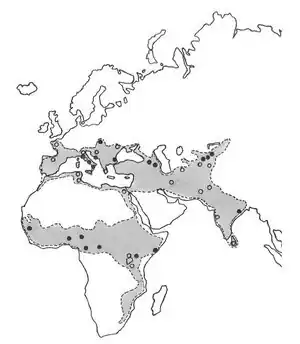Bhanja virus
| Bhanja bandavirus | |
|---|---|
| Virus classification | |
| (unranked): | Virus |
| Realm: | Riboviria |
| Kingdom: | Orthornavirae |
| Phylum: | Negarnaviricota |
| Class: | Ellioviricetes |
| Order: | Bunyavirales |
| Family: | Phenuiviridae |
| Genus: | Bandavirus |
| Species: | Bhanja bandavirus |
The Bhanja virus is a tick-borne virus first discovered in a tick (Haemaphysalis intermedia) taken from a paralyzed goat in Bhanjanagar, India in 1954.[1] Bhanja virus in humans was first documented in 1974 when Charles Calisher was working with the virus in a lab and contracted it himself.[2] His experience with the virus was mild and included symptoms of mild aching in muscles and joints, moderate headache, slight photophobia. The Bhanja virus is a member of the Bhanja virus serocomplex and is a member of the Bunyavirales order.[1][3]
Transmission
The Bhanja virus is transmitted from ticks and has furthermore mainly been isolated from the ticks of the genera Dermacentor and Haemaphysalis, although it can be transmitted by any Ixodidae ticks. Bhanja virus is not known to be transmitted between humans.[1]
Hosts
The Bhanja virus has been found in vertebrate animals, most commonly in sheep, goats, cattle, African hedgehogs (Atelerix albiventris), and African ground squirrels (Xerus erythropus). It has been known to be pathogenic in small animals and children and can also affect adult humans.[4]
Location

The Bhanja virus has been isolated in Europe, including: Italy, Croatia, Bulgaria, Romania, Eastern Slovakia, in Asia, including: India, Kirghizia, Kazakhstan, Azerbaijan, Armenia and in Africa, including Senegal, Guinea, Nigeria, Cameroon, Central Africa, Kenya, Somali. There is a possibility that migratory birds play a role in spreading the virus by carrying infected ticks on them to new regions.[5]
Infection
Symptoms and signs
The Bhanja virus produces febrile illness in humans with symptoms including photophobia, vomiting, meningoencephalitis, and slight or partial pa ralysis.[1]
Prevention
Prevention is that of any tick bite, avoid excessive foliage and bushy areas. If you do come in contact with these areas, wear long sleeves and pants to cover as much skin as possible. Be specifically careful in areas used to graze or feed goats or sheep.[6]
Treatment
Treatment is dependent upon the severity of the symptoms. Due to viral infections not responding to antibiotics, treatment is mainly to reduce the signs and symptoms; for which acetaminophen is suggested.[2]
References
- 1 2 3 4 Hubálek Z (2009). "Biogeography of tick-borne bhanja virus (bunyaviridae) in Europe". Interdiscip Perspect Infect Dis. 2009: 372691. doi:10.1155/2009/372691. PMC 2825549. PMID 20182535.
- 1 2 Calisher CH, Goodpasture HC (1975). "Human infection with Bhanja virus". Am J Trop Med Hyg. 24 (6 Pt 1): 1040–2. doi:10.4269/ajtmh.1975.24.1040. PMID 812372.
- ↑ Plyusnin, A.; Beaty, B.J.; Elliott, R.M.; Goldbach, R.; Kormelink, R.; Lundkvist, Å.; Schmaljohn, C.S.; Tesh, R.B. "ICTV 9th Report (2011) Negative Sense RNA Viruses (2011) Negative Sense RNA Viruses Bunyaviridae". International Committee on Taxonomy of Viruses (ICTV). Archived from the original on 19 August 2022. Retrieved 20 December 2019.
List of other related viruses which may be members of the family Bunyaviridae but have not been approved as species
- ↑ Mehlhorn, Heinz (2012). "8. The Huge Risks Due to Hyalomma Ticks". Arthropods as Vectors of Emerging Disease. Springer. pp. 181, 183. ISBN 9783642288425. Archived from the original on 2023-06-30. Retrieved 2023-03-18.
- ↑ "Bhanja Virus Infection in Hedgehogs and Bears (Viral Disease Link)". wildpro.twycrosszoo.org. Archived from the original on 2017-06-19. Retrieved 2014-07-25.
- ↑ Armed Forces Pest Control Board Washington DC; Gingrich, John B.; Harlan, Harold J.; Perkins, Peter V.; Trosper, James H. (2001). "V. Militarily Important Vector-Borne Diseases with Short Incubation Periods (<15 days) §N. Bhanja Virus". Regional Disease Vector Ecology Profile: Central Europe (PDF). Defense Pest Management Information Analysis Center, Armed Forces Pest Management Board, Forest Glen Section, Walter Reed Army Medical Center. pp. 113–5. ADA514062. Archived (PDF) from the original on September 19, 2021.